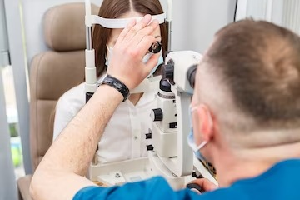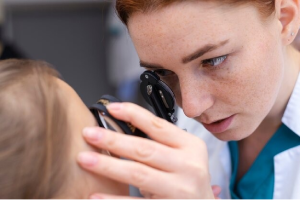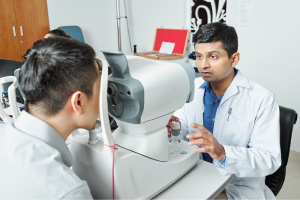A YAG capsulotomy is a laser surgical procedure performed after cataract surgery to address a common complication called posterior capsular opacification (PCO). PCO occurs when the capsule that holds the artificial intraocular lens (IOL) becomes cloudy or opaque, causing visual disturbances similar to those experienced before cataract surgery. YAG capsulotomy is a safe and effective way to restore clear vision in individuals who develop PCO.
Here’s an overview of the YAG capsulotomy procedure:
Indications:
YAG capsulotomy is performed when posterior capsular opacification occurs after cataract surgery. PCO can cause symptoms such as blurred or hazy vision, glare, and difficulty seeing in certain lighting conditions.
Preparation:
Before the procedure, the EYE is typically dilated with EYE drops to allow the surgeon better access to the capsule.
Procedure:
YAG capsulotomy is a relatively quick outpatient procedure performed in the ophthalmologist’s office.
The patient is seated in a chair, and anesthetic EYE drops are administered to numb the EYE .
A YAG laser is used to create a small, precise opening in the cloudy posterior capsule.
The laser energy is focused on the center of the capsule, creating an opening through which light can pass, restoring clear vision.
Postoperative Care:
After the procedure, patients may experience improved vision almost immediately.
EYE drops may be prescribed to prevent inflammation and infection.



The decision to undergo YAG laser treatment, specifically YAG capsulotomy, is typically made based on the presence of visual symptoms and an examination by an ophthalmologist. If you have undergone cataract surgery and experience certain visual issues, your EYE care professional will assess your condition to determine if YAG laser treatment is necessary. Here are some indicators that may suggest the need for YAG laser treatment:
Blurred Vision:
If you experience blurred vision, especially if it develops gradually after cataract surgery, it could be a sign of posterior capsular opacification (PCO), which is a common reason for YAG laser treatment.
Glare or Halos:
Glare or halos around lights, particularly in low-light conditions, may indicate the presence of PCO. This symptom can affect the quality of your vision and may prompt the need for YAG laser treatment.
Hazy or Cloudy Vision:
Hazy or cloudy vision is a common symptom of PCO. If you notice a decline in the clarity of your vision, it is essential to consult with your EYE care professional.
Difficulty Seeing in Certain Lighting Conditions:
PCO can cause difficulty seeing clearly in specific lighting conditions, such as bright lights or sunlight. If you find that your vision is compromised under certain lighting, it could be a sign of PCO.
Visual Disturbances:
Any new visual disturbances or changes in your vision after cataract surgery should be promptly reported to your EYE care professional. This may include changes in color perception or overall visual discomfort.
Routine EYE Examination:
Regular follow-up appointments with your ophthalmologist after cataract surgery are crucial. During these appointments, your EYE care professional will assess the health of your eyes, including the condition of the posterior capsule, and determine if YAG laser treatment is necessary
Rapid Improvement in Vision:
YAG capsulotomy offers swift enhancement in vision, often noticeable during or immediately following the procedure. Patients experience improved visual clarity promptly.
Non-Invasive Procedure:
This procedure is non-invasive, typically requiring no incisions or sutures. It’s conducted using a specialized laser, minimizing physical trauma to the EYE .
Outpatient Convenience:
YAG capsulotomy is performed as an outpatient procedure in Mr Deshmukh office, allowing patients to return home shortly after completion, eliminating the need for hospital stays.
Minimal Discomfort:
Generally well-tolerated, patients undergoing YAG capsulotomy may experience minimal discomfort, with the procedure causing little to no pain.
No Anesthesia Required:
Procedure is done under topical anesthesia that is numbing eye drops are used to desensitize the eye.
Restoration of Visual Clarity:
YAG capsulotomy effectively addresses the cloudiness or haziness in the posterior capsule following prior cataract surgery, restoring clear vision for patients.
It’s crucial to acknowledge that while YAG capsulotomy is a routine and safe procedure, like any surgery, there are potential risks. These include increased intraocular pressure, retinal detachment, or inflammation. Patients should engage in comprehensive discussions with Mr Deshmukh to understand the potential risks and benefits before proceeding with the procedure.
During a YAG laser treatment, specifically YAG capsulotomy, the laser is used to create an opening in the cloudy posterior capsule of the EYE . This procedure is commonly performed after cataract surgery to address posterior capsular opacification (PCO), a condition where the capsule that holds the artificial intraocular lens becomes cloudy, leading to vision disturbances. Here’s an overview of what happens during a YAG laser treatment:
Preoperative Evaluation:
Before the YAG laser treatment, your EYE care professional will conduct a thorough examination of your eyes to assess the health of the anterior and posterior segments. This evaluation helps ensure that YAG capsulotomy is the appropriate treatment for your condition.
Patient Preparation:
You will be seated comfortably in an examination chair, and anesthetic EYE drops will be administered to numb the surface of your EYE . The use of anesthetic drops helps ensure that you are comfortable and experience minimal discomfort during the procedure.
Focusing the Laser:
Your EYE care professional will use a YAG laser, which emits short pulses of light at 1064 nanometers. The laser is focused precisely on the central portion of the cloudy posterior capsule.
Capsulotomy:
The laser is used to create a small, circular opening in the center of the posterior capsule. This opening allows light to pass through, restoring clear vision by eliminating the opacity in the capsule.
Immediate Improvement in Vision:
In many cases, patients experience an immediate improvement in vision during or shortly after the YAG capsulotomy procedure. The creation of the opening allows light to reach the retina without obstruction, resulting in clearer vision.
Postoperative Care:
Following the procedure, your EYE care professional may prescribe anti-inflammatory EYE drops to prevent inflammation and reduce the risk of complications. Most patients can resume normal activities immediately after the procedure.
Follow-Up Appointment:
A follow-up appointment may be scheduled to ensure that the EYE is healing properly and to monitor any changes in intraocular pressure.
Important Considerations:
The YAG capsulotomy procedure is typically quick, taking only a few minutes to complete.
The laser used in YAG capsulotomy is precise and focused, minimizing the risk of damage to surrounding EYE structures.
Patients may notice floaters or tiny specks in their vision immediately after the procedure. These are typically remnants of the cloudy capsule and usually settle over time.
YAG capsulotomy is considered a safe and effective procedure, providing rapid improvement in vision for individuals with posterior capsular opacification. While complications are rare, it’s important to follow the postoperative care instructions provided by your EYE care professional and attend any scheduled follow-up appointments to ensure optimal outcomes.
1. What is YAG Laser Treatment, and what EYE conditions does it address?
YAG Laser Treatment involves the use of a focused laser beam to treat posterior capsule opacification (PCO) or secondary cataracts following cataract surgery. It effectively clears the cloudy membrane behind the intraocular lens.
2. How does YAG Laser Treatment differ from other EYE procedures like cataract surgery or LASIK?
YAG Laser Treatment specifically targets cloudiness in the posterior capsule after cataract surgery, while cataract surgery involves the removal of the clouded lens. LASIK is a refractive surgery for vision correction but differs in purpose from YAG capsulotomy.
3. Who is an ideal candidate for YAG Laser Treatment performed by Mr Deshmukh?
Patients who have undergone cataract surgery and experience blurred vision due to posterior capsule opacification are suitable candidates for YAG Laser Treatment. Mr Deshmukh assesses eligibility during a comprehensive EYE examination.
4. What can patients expect during and after YAG Laser Treatment in Mr Deshmukh care?
The procedure is brief and typically painless. After treatment, patients often experience immediate improvement in vision. Some may notice floaters or spots, which usually resolve quickly.
5. Are there any potential risks or complications associated with YAG Laser Treatment by Mr Deshmukh?
YAG Laser Treatment is generally safe. However, potential risks include increased intraocular pressure, retinal detachment, or inflammation Mr Deshmukh discusses these risks and ensures proper patient education before the procedure.










